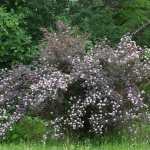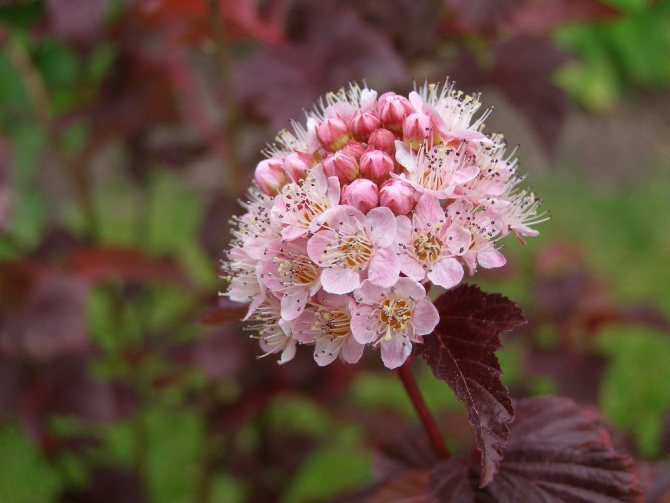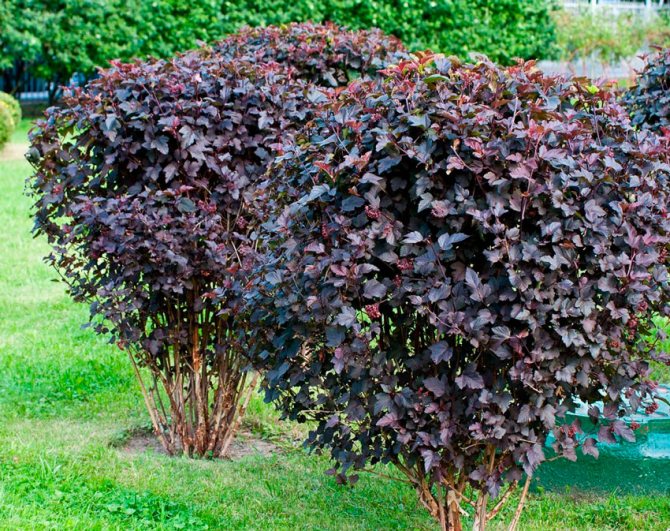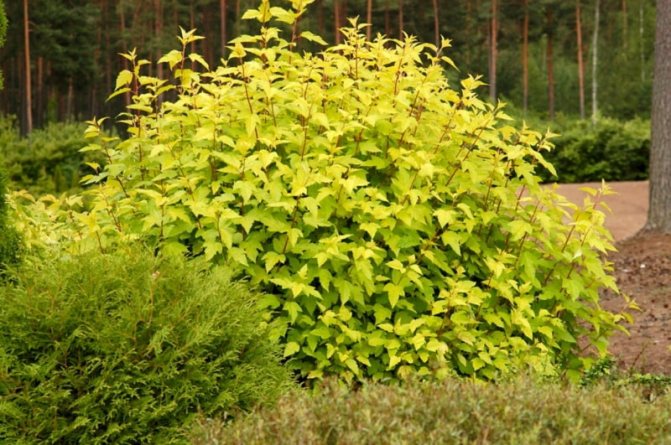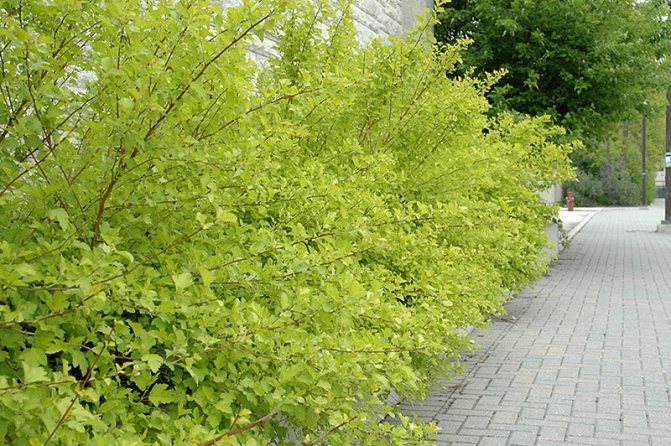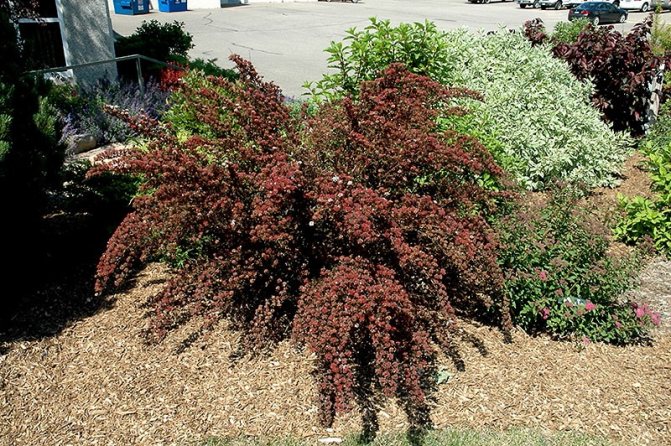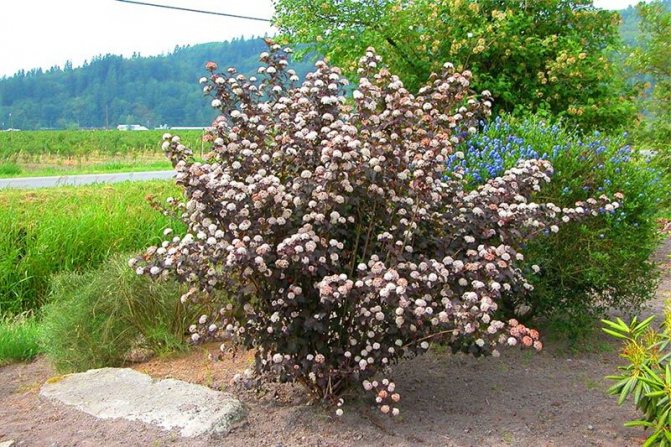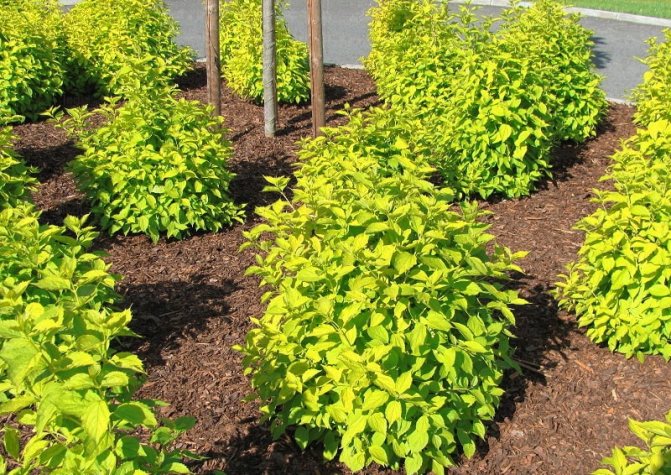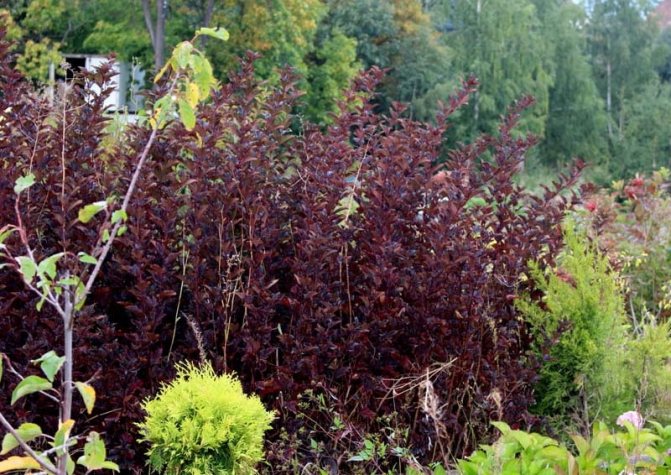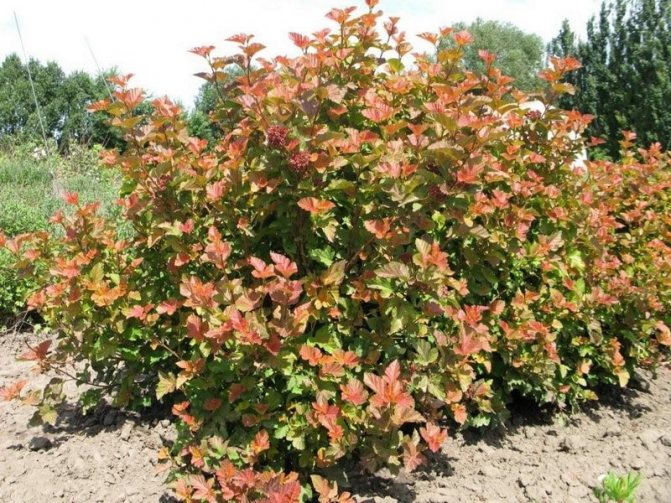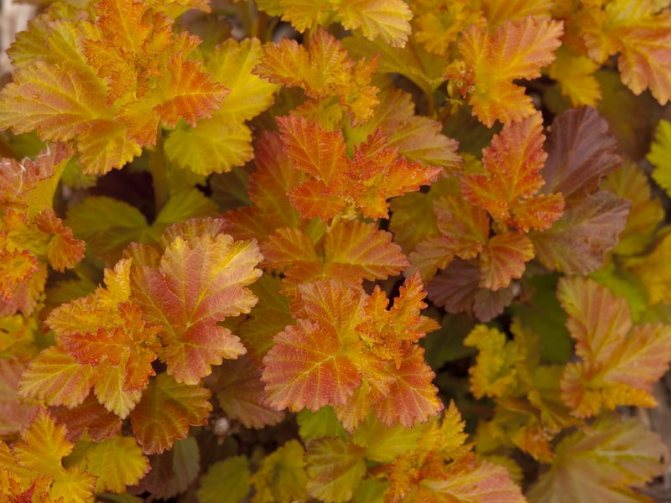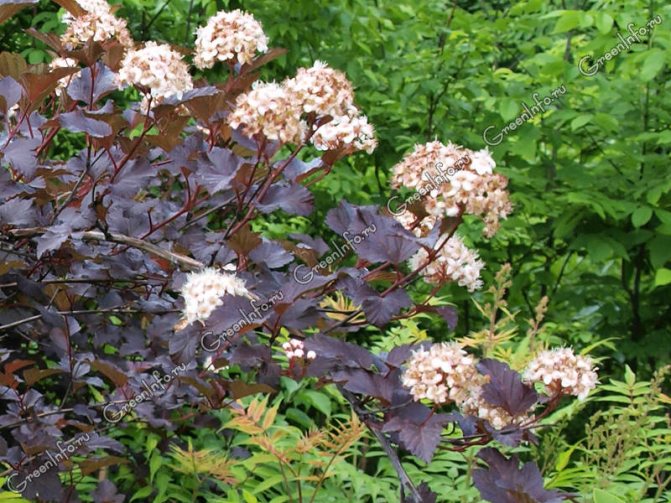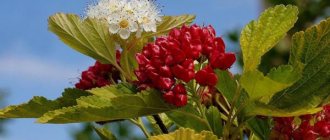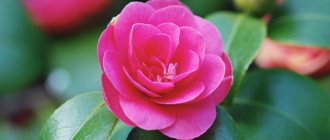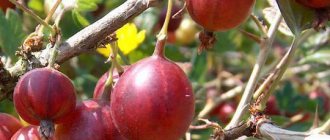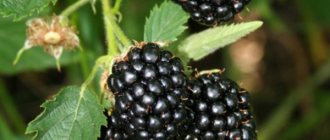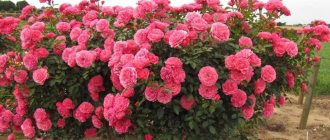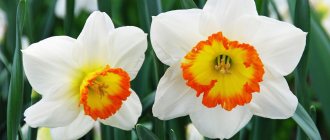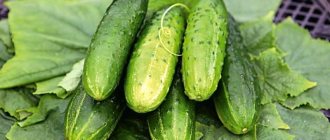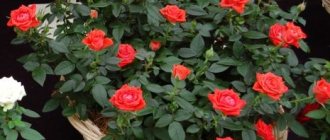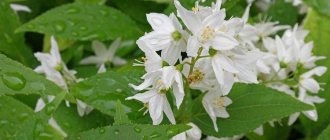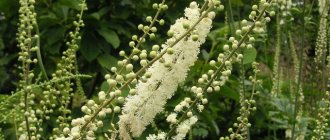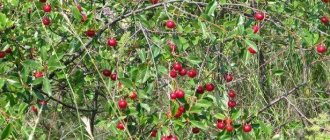The work of modern breeders can be compared to the activities of underground revolutionaries. In any case, conspiracy is an integral part of their activities. It is understandable, the work on the variety is painstaking and time-consuming. A variety, unless of course it is an accidental find in nature, cannot be created overnight. Its creation is not a one-time act, but a long-term work. The variety must first be thoroughly checked and tested. It is possible that the first impression from him is deceiving, and this is not a very stable mutation, prone to reversion - a return to the wild form. In general, it makes sense to ring the whole world, to attract attention, when no one and nothing can prevent the author from making money on a newbie.
Diabolo calyx-leaved phytocarp
Be that as it may, the viburnum-leaved vesicle "Diabolo" entered the garden use as a mysterious Mister X. In fact, there was nothing supernatural about his appearance. After all, purple and yellow colors by nature itself are laid in the green of the leaves, just as white light absorbs all the colors of the rainbow. The most striking example of this phenomenon is still the Thunberg barberry. But everything goes to the fact that the vesicle will soon press him on the podium.
The history of the appearance of "Diabolo" is still very vague. It is only known that he appeared in Germany, was selected by H.T. Schadendorf in Ellerbek. In Europe, Diabolo began to glow in the mid-1990s. And the first Diabolo seedlings appeared on the Russian market at the very beginning of the 21st century. He immediately declared himself a contender for the title of the brightest of the purples. But its absolute winter hardiness, undoubtedly, turned out to be no less significant.
What does the bladder look like
Modern varieties of the bladder are striking, first of all, by the varied and very interesting color of the leaves. The shrub itself is capable of reaching a height of 3 m, although there are also quite dwarf varieties that do not exceed 80-100 cm.
The branches of the vesicle are thin, but luxuriantly growing in all directions, drooping at the ends, form a hemispherical, dense crown, which is clearly visible in the photo of the plant.
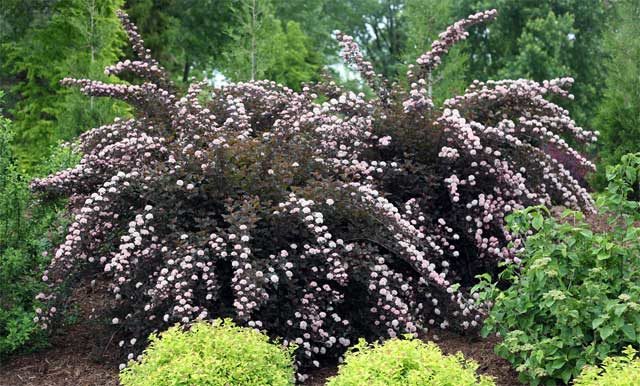
Medium-sized rounded-elliptical leaves, containing from 3 to 5 lobes, have a serrate-toothed edge. Their color can be all shades of green, yellow, red-orange, and even a combination of several colors.
Attention! The leaf color of many cultivars changes from spring to summer to autumn, making it even more attractive to plant in the garden.
Next, a detailed description of the main species and varieties of the vesicle and their photos will be given, using which you can choose the most suitable plants for your garden.
How the bladder grows
In terms of its growth and development rates, the bladder can be ranked as a fairly rapidly developing plant. Already at 4 years old, the plants begin to bear fruit, and, having reached their maximum height, they begin to grow in breadth. The life span of one bush can be up to 80-100 years. A single plant in width can grow up to 4 meters in diameter. The growth rate of the vesicle is such that the plant gives an increase of about 35-40 cm per year. Depending on the variety, the bushes reach their maximum height in 6-10 years.
Young leaves usually open in April, and leaf fall occurs depending on the climatic conditions of the region from the beginning to the end of October.
Varieties of the bladder
In nature, there are about 14 species belonging to the genus vesicle, which are distributed mainly in East Asia and North America. But in culture, only two species are used: the Amur bladder and Kalinolistny.
These species differ from each other, first of all, in the geography of distribution. The Amur vesicle was found and lives to this day in the undergrowth of the Far East, in the north of China and Korea. Kalinolistny also originates from North America, where it grows in mixed forests, along river terraces.
The two species can also be distinguished by the size and shape of the leaves. Amur leaves are larger, have a slightly heart-shaped shape with obligatory light gray pubescence on the underside.
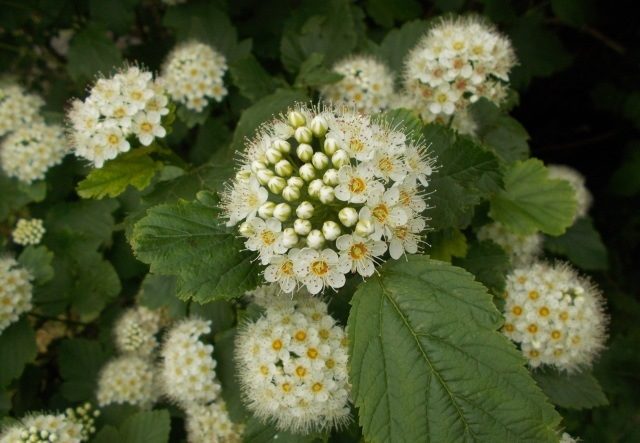

The Amur vesicle, in contrast to the viburnum, is less common in horticulture, although it is not inferior to its counterpart in terms of unpretentiousness and frost resistance. Perhaps this is due to the small variety of varieties currently available:
- Aureomarginate - green leaves have a dark golden border.
- Nana is a dwarf variety with a compact dark green crown.
Care
Care is mainly reduced to timely and competent watering, as well as fertilization and weeding of the near-stem soil. The plant does not tolerate drought, especially in the hot summer period with an active sun. The optimal watering scheme is 2-3 times a week, while at least 4 buckets of water should go to one bush. It is important that the water does not fall directly on the leaves, as burns may appear on them. The same recommendations apply to inflorescences. It is optimal to perform the procedure early in the morning or in the evening after sunset. If necessary, loosen the soil, especially if there is no mulching.
Excessive waterlogging is also undesirable for the vesicle. In this case, there is a possibility of damage to the shoots by powdery mildew.
Top dressing is usually carried out 2 times a year - in spring and autumn. This applies to a greater extent to already adult plants that have reached 2-3 years of age. Fertilizer for the spring period is prepared at the rate of 0.5 kg of cow dung, 1 tbsp. l. urea, 1 tbsp. ammonium nitrate for 1 bucket of water. The resulting solution is poured under the roots until it is completely absorbed into the soil. An adult bush requires 1.5 buckets (10-15 liters) of liquid. In the fall, a slightly different recipe is used: for 1 bucket of water (10 l), 2 tbsp is taken. l nitroammophoska.
Cultivars of bladderwort with a photo and description
Despite the fact that in Russian horticulture, the viburnum bladder has been used since the middle of the 19th century, the active breeding of varieties of this culture began only about 10-20 years ago. But at the moment, this shrub is so popular that new varieties appear almost every year.
Amber Jubilee
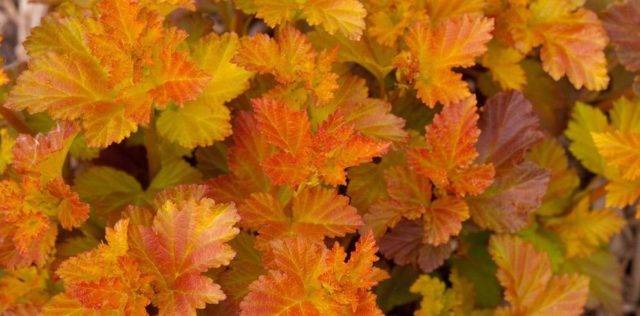

The variety was bred by English breeders and named in honor of the diamond anniversary of Queen Elizabeth II of England. One of the most beautiful cultivars of the viburnum bladder. The color of the leaves is very rich, and at the same time they look unusually festive, especially when swaying from the breeze. At the ends of the branches, the shade of the foliage is closer to red-orange, with a fiery tint. And towards the center of the crown, the leaves also acquire yellow and greenish shades, which pass into each other in a wide variety of combinations. The bush reaches 2 m in height and 1.5 m in width. The leaves demonstrate their colorful play of colors and shades on bushes growing in the open sun.
André
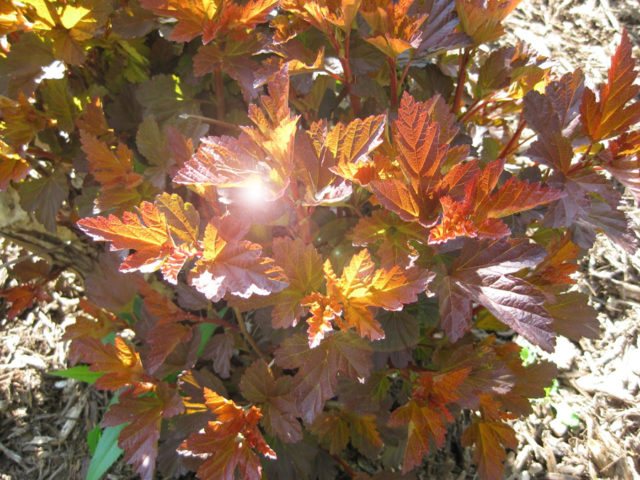

The variety is distinguished by the decent size of the bushes - up to 3 m in height and up to 2.5 m in width.In the spring, the leaves bloom pinkish-red, later they clearly show a bronze tint. However, when in the shade, the leaves turn green. The fruit also changes its color from red to brownish.
Aurea
One of the oldest varieties of the viburnum bladder, which has a second name - Luteus. Plants are characterized by the fact that when blooming, the leaves have a beautiful golden yellow color, but pretty soon they become just light green. However, closer to autumn, the golden color of the leaves appears again. It blooms with white inflorescences, which bloom in the second half of July. Young shoots are also golden in color.
Gold Spirit
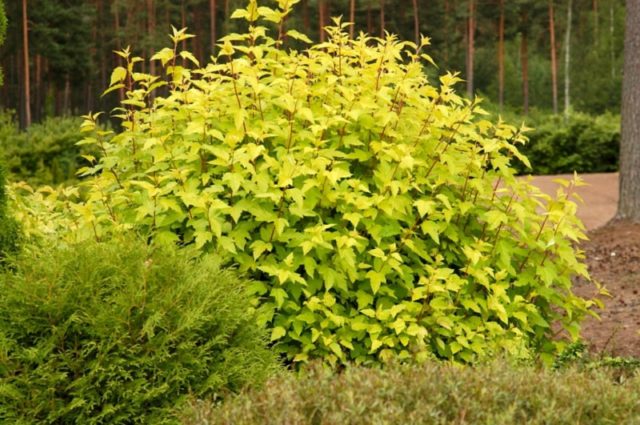

The variety is an excellent alternative to the already slightly outdated Luteus, since the golden yellow leaves, when they appear, retain their hue throughout the growing season. The bushes reach a height of 2 m and are good for any haircut.
Darts Gold
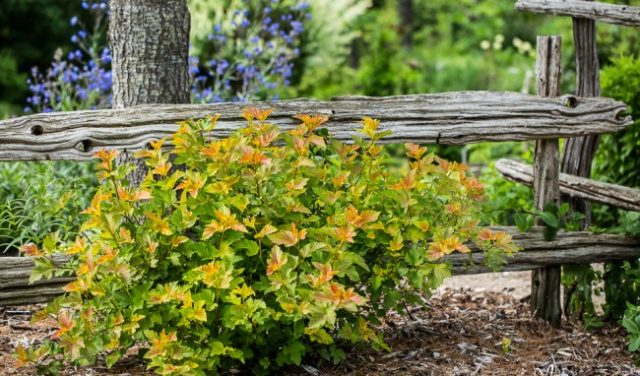

Another very popular Dutch cultivar with golden foliage in recent years. It is a hybrid of Luteus and Nanus varieties. The height does not exceed 1.5 m. The leaves retain their golden hue for almost the entire season, only in the second half of summer they become slightly greenish. But in the fall they are covered with a noticeable crimson. The flowers are creamy white. In 1993, this variety received the prestigious award of the English Royal Society of Gardeners.
Diablo
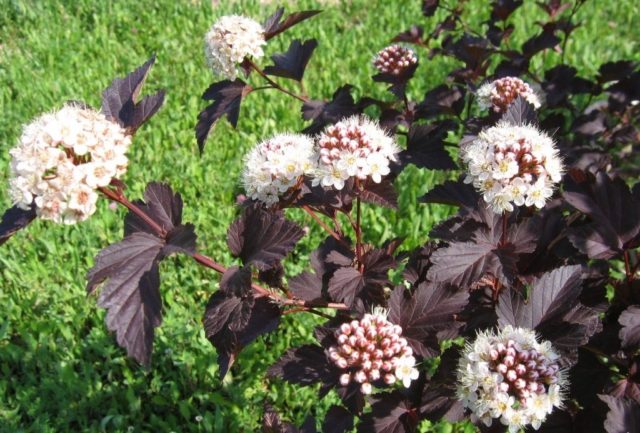

Despite the mysterious origin of Diablo, this does not prevent him from being one of the best among other dark-colored cultivars of the viburnum bladder. The bushes have a spreading shape, up to 3 m high. Throughout the season from spring to autumn, smooth and almost glossy leaves have a uniform dark purple hue. When planted in shady conditions, the leaves turn green, but the purple hue, although weak, remains. For its beauty, unpretentiousness and frost resistance, the variety was also awarded in 2002 with the prize of the Royal Horticultural Society.
Lady in Red
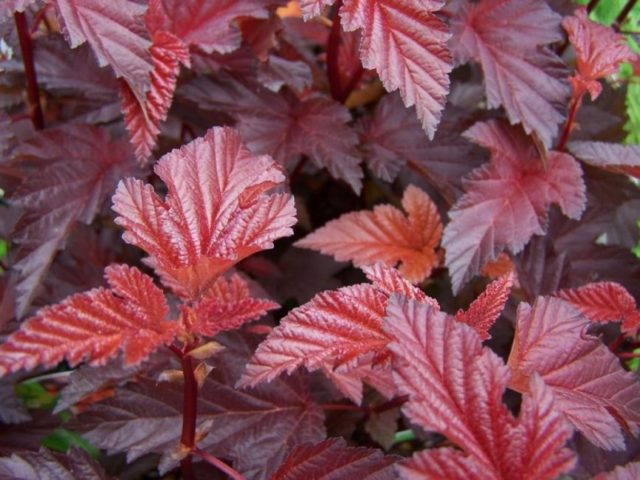

Quite a new cultivar of Viburnum bladder, but managed to show itself so well that in 2012 it also received the aforementioned highest garden award in England. Dissolving, wrinkled leaves have a bright red hue, which gradually darkens and by the second half of summer they acquire an almost beet-like color. The flowers have an attractive pinkish tint. The height of the bushes is up to 1.5 m.
Little Devil
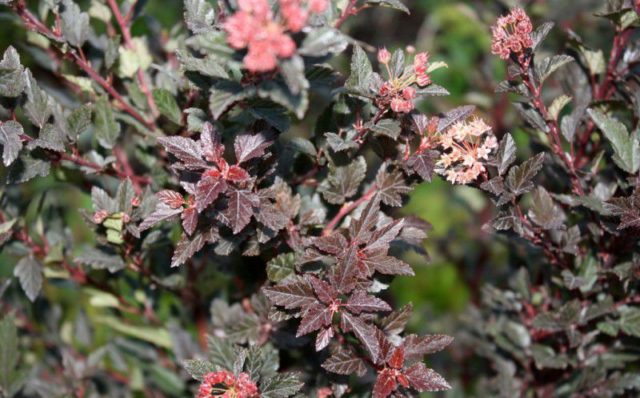

Belongs to a series of so-called dwarf cultivars of the viburnum bladder, reaching a height of no more than 90-100 cm. At the same time, the bush can grow up to 70 cm in diameter in width. The graceful leaves have a maroon hue throughout the growing season. Flowers are small, pink.
Little Joker
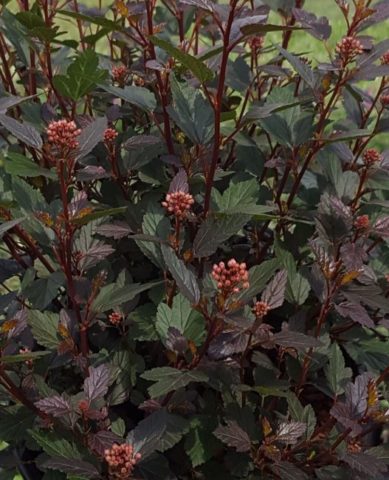

A dwarf variety, bred in Holland, grows from 50 to 100 cm in height. Small corrugated leaves have a bright cherry color when blooming. Subsequently, they turn to purple-brown. White-pink flowers bloom in June.
Little Angel
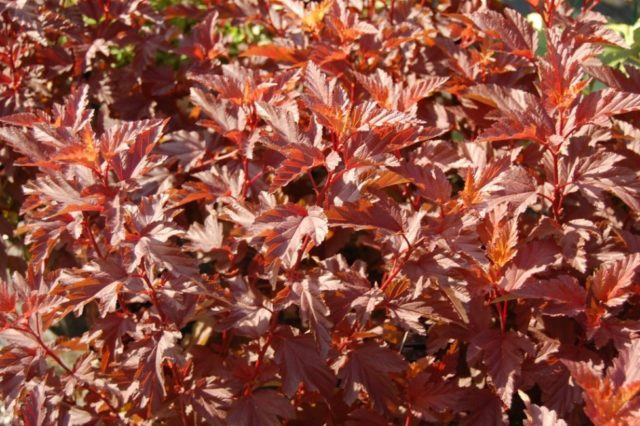

Another representative of the dwarf family of the Viburnum perforatum. The Dutch variety Little Angel is very small in size, up to 60 cm in height and the same in width. The crown is quite dense, has a pillow-like shape. The leaves are very small, in spring they bloom with an orange tint. Later they turn beet brown.
Ideal for container growing on balconies or terraces.
Luteus
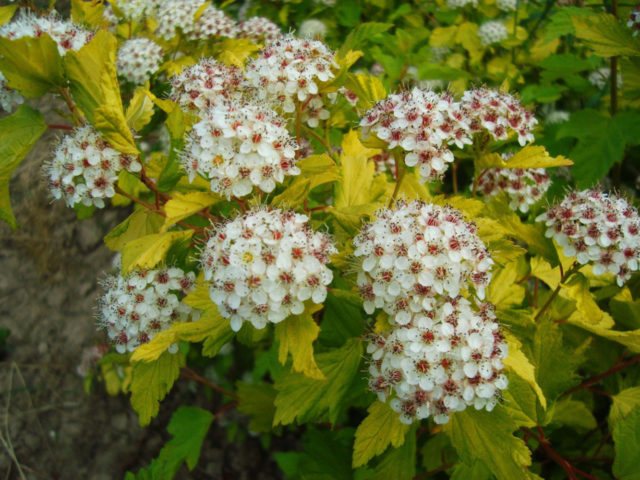

The second synonymous name of the Aurea variety.
Mindia (Coppertina)
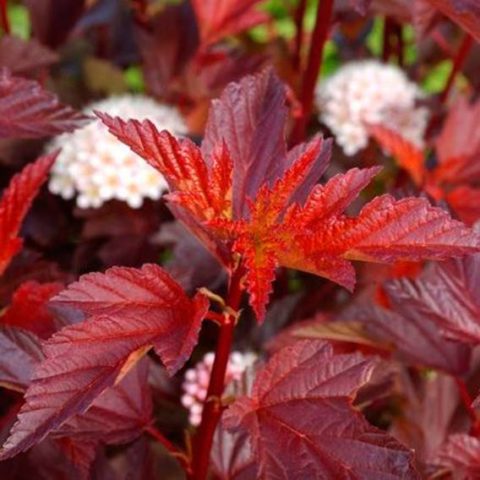

This cultivar of Viburnum bladder, bred by breeders in France, is considered the most "red" of all existing at the moment. Bushes grow both in height and in width up to two meters. When opening, the leaves can be, depending on the location in the crown, yellowish, orange or reddish shades.Then the color changes to cherry, brown or maroon. In those places of the crown, where the sun gets much less, the brownish-green tint of the leaves is clearly distinguished.
Midnight
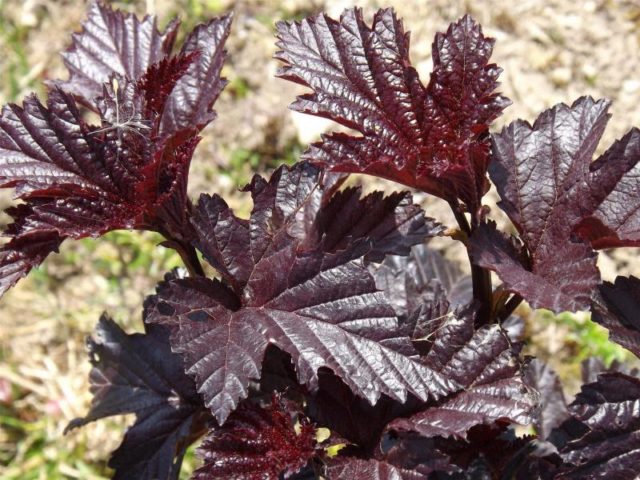

It is the darkest of the red-leaved cultivars of the viburnum bladder. If at the ends of the shoots the leaves are dark purple in color, then towards the center they become almost black. True, in autumn the leaves turn red-orange. Plant height is average - about 1.5 m, crown width - up to 1.8 m. Flowers are whitish-pink.
Nugget
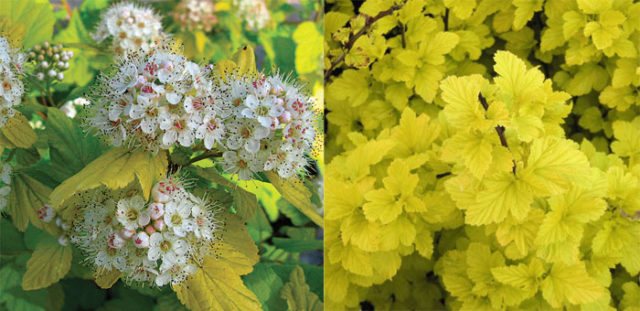

Another medium-sized (up to 2.5 m) cultivar of viburnum bladder, which boasts bright yellow foliage. True, the shade changes during the season: in the spring it is very bright and saturated, by the middle of summer it becomes lighter, and in the fall it acquires some gold. The leaves are large and corrugated. Creamy flowers with red stamens appear in mid-June, but may reappear in late summer at the same time as ripening fruits.
Red Baron
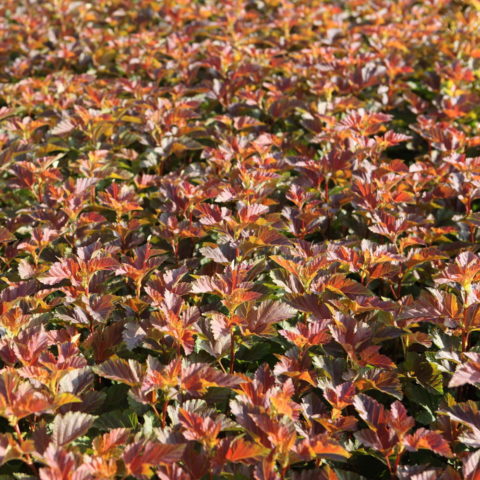

A red-leaved bladder variety with a very attractive hue, somewhat reminiscent of Diabolo, but with smaller leaves. Their rich burgundy color gets additional bronze shades in the fall. In the shade, a brownish color begins to predominate, but a red tint on the leaves still remains.
Summer Vine


The spring leaves of this cultivar of Viburnolia are distinguished by their wine-red color with a characteristic metallic luster. In summer, greenish tints can be observed on them, and in autumn, bronze ones. The height of the bushes is no more than 1.5 m.
Center Glow
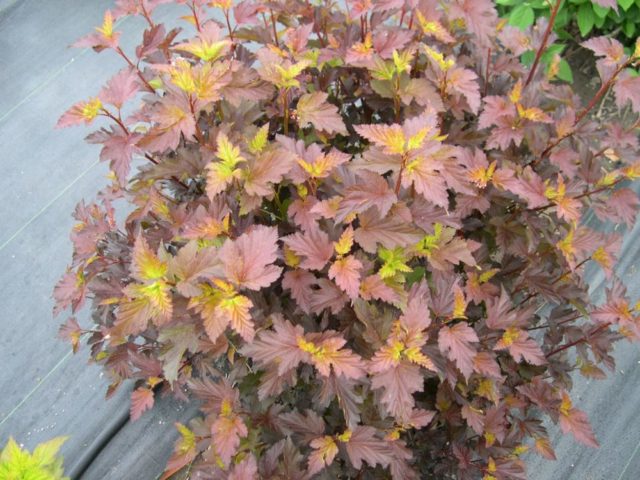

The leaves of this viburnum bladder are unusually bright, especially in the light, due to the golden sheen in the center of the leaf, which is inherent in them when they are in bright sunlight. Young leaves can be dark red or light maroon. With age, they only acquire an even deeper and darker shade.
Tilden Park
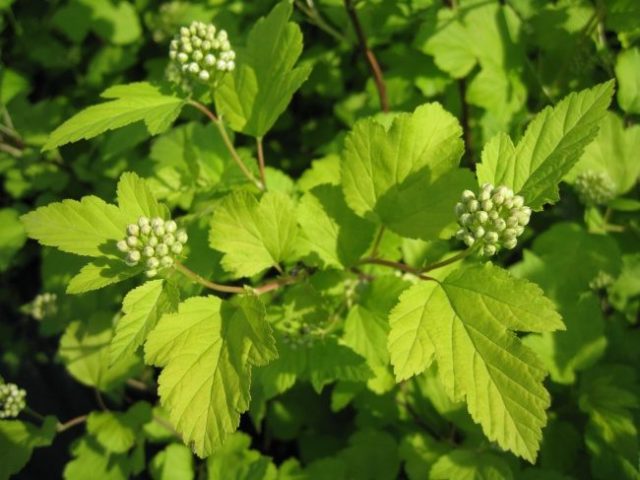

To slightly diversify the colorful palette of the colored leaves of the Vinegaria bladder, you can plant the Tilden Park variety in the garden. Its corrugated leaves have an ordinary light green hue. But, like many other varieties of the viburnum bladder, its bushes, up to 150 cm high, cut well and lend themselves to molding. The flowers are white. It goes well with any variegated and especially dark-colored varieties.
Chameleon
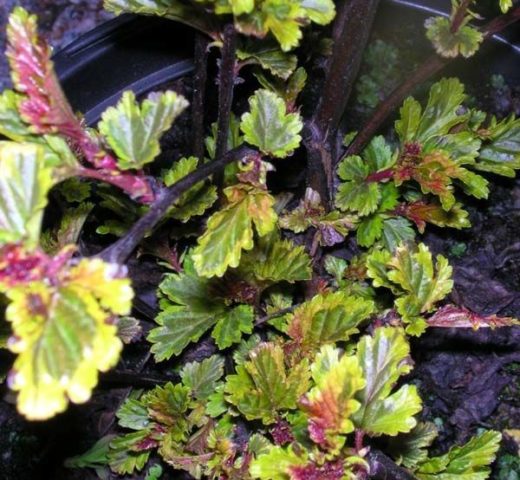

A very interesting colorful cultivar of the Vine-leaved vesicle up to 1.5 m high with unusual color characteristics. The general color of the leaves is dark green. Against this background, spots of any shade can be located: red, orange, yellow. But a decorative strip runs along the entire finger-like border of the leaves. In young leaves, it has a purple hue; with age, it acquires a light green or lemon color.
Attention! Sometimes the leaves turn completely purple-red. Shoots with such foliage are usually cut out in order to prevent the development of non-varietal traits.
Shuh (Shuch)
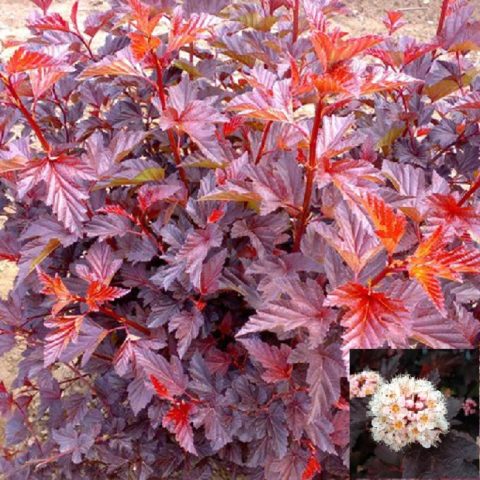

The young leaves of this 1.5-2-meter shrub have an expressive cherry color, which changes to dark purple in summer. In autumn, the color of the foliage remains exactly the same as in summer. Flowers are white with pink.
Reproduction methods
The Little Angel bubblegum is propagated in any of the following ways:
- layering;
- seeds;
- cuttings;
- dividing the parent bush.
The vegetative method is the most reliable, the Little Angel cultivar will take root without problems with a high degree of survival.
Advice! The most productive breeding method is by cuttings.
The Little Angel hybrid is bred with seeds mainly in nurseries, even with good germination of the planting material, it will take at least 3 years from laying the seeds to determining the seedling for the site.And there is no guarantee that the varietal characteristics of the young growth will be preserved.
Features of cultivation of the vesicle
The bladder, for all its beauty, is an amazing plant in terms of unpretentiousness to growing conditions. It can tolerate shade, drought, gas and smoke. Although all variegated forms show their true beauty exclusively in the sun.
Shrubs are not at all demanding on the composition of the soil. Only the stagnation of moisture at the roots is poorly tolerated, therefore drainage is necessary when planting.
They perfectly tolerate Russian frosts, only in the most severe winters can the tips of young shoots freeze slightly. Which, however, has practically no effect on the general condition of the plants, since they are easy to prune.
They are not very susceptible to the invasion of various parasites.
It propagates well by seeds, cuttings and layering. Moreover, during seed propagation of the golden forms of the vesicle, the original properties of the mother plant are often retained.
Use in the garden
The bladder is good in single and group plantings. A large, spreading shrub with bright leaves is identified in the center of the lawn or in the corner of the garden. It can become the backdrop for a flower garden. With belt planting, plants are good as a hedge, for zoning a site and decorating borders.
The bubble plant can withstand gas pollution well, therefore it is suitable for large cities. Even near roads, it will actively grow, create protection from dust and exhaust. Since it tolerates pruning well, the bushes are given any shape (ball, cylinder, solid tape). Varieties with lilac and yellow leaves are perfectly combined.
Post Views: 1

